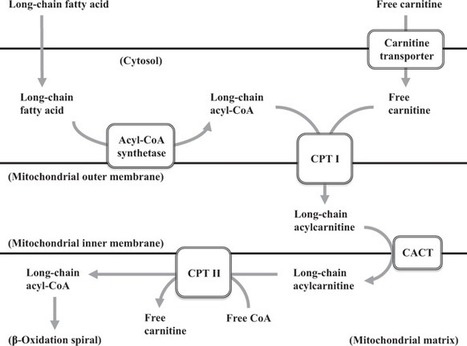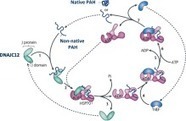 Your new post is loading...
 Your new post is loading...

|
Scooped by
HAS-veille
January 10, 2019 8:02 AM
|
Neonatal screening programmes have been introduced in almost all European countries. In practice there are large differences, especially in the panel of conditions that are screened for, often without clear reasons. Policy making on a European level is lacking in contrast to the situation in the USA. Professionals have the knowledge to expand the panels but are dependent on policy-makers for the necessary funds. This paper is a call on the EU Commission to take up a role in providing equal access to neonatal screening for all children within the EU.

|
Scooped by
HAS-veille
January 9, 2019 9:34 AM
|
Over the past 20 years, research on fragile X syndrome (FXS) has provided foundational understanding of the complex experiences of affected individuals and their families. Despite this intensive focus, there has been little progress on earlier identification, with the average age of diagnosis being 3 years. For intervention and treatment approaches to have the greatest impact, they need to begin shortly after birth. To access this critical timespan, differential methods of earlier identification need to be considered, with an emerging focus on newborn screening practices. Currently, barriers exist that prevent the inclusion of FXS on standard newborn screening panels. To address these barriers, an innovative program is being implemented in North Carolina to offer voluntary screening for FXS under a research protocol, called Early Check. This program addresses the difficulties observed in prior pilot studies, such as recruitment, enrollment, lab testing, and follow-up. Early Check provides an opportunity for stakeholders and the research community to continue to gain valuable information about the feasibility and greater impact of newborn screening on the FXS population.

|
Scooped by
HAS-veille
December 18, 2018 8:05 AM
|
Am J Med Genet A. 2018 Dec 17. doi: 10.1002/ajmg.a.60681. [Epub ahead of print]

|
Scooped by
HAS-veille
December 17, 2018 8:10 AM
|

|
Scooped by
HAS-veille
December 10, 2018 5:51 AM
|

|
Scooped by
HAS-veille
December 5, 2018 5:54 AM
|

|
Scooped by
HAS-veille
December 3, 2018 8:38 AM
|
The purpose of this literature review is to explore the existing knowledge on MPS II and to inform the nursing community about the prevalence of MPS II and examine why it is important to offer screening to parents of a newborn or child.
Conclusion:
The birth of a child with the rare disorder such as MPS II will change the lives of families forever. Early identification and treatment can slow down decline in health and improve quality of life of children and thei

|
Scooped by
HAS-veille
November 7, 2018 8:20 AM
|

|
Scooped by
HAS-veille
November 7, 2018 8:16 AM
|

|
Scooped by
HAS-veille
October 24, 2018 8:45 AM
|

|
Scooped by
HAS-veille
October 18, 2018 8:19 AM
|

|
Scooped by
HAS-veille
October 15, 2018 9:44 AM
|
A decision tree model was built to estimate the economic impact of introducing screening for X-linked adrenoleukodystrophy (X-ALD) into an existing tandem mass spectrometry based newborn screening programme.

|
Scooped by
HAS-veille
September 27, 2018 8:30 AM
|
|

|
Scooped by
HAS-veille
January 9, 2019 9:36 AM
|
Fatty acid β-oxidation (FAO) disorders have a wide variety of symptoms, not usually evident between episodes of acute decompensations. Cardiac involvement is frequent, and sever

|
Scooped by
HAS-veille
January 3, 2019 8:18 AM
|
Cystic fibrosis newborn screening (NBS), has not yet become a reality in all countries. We therefore compared the demographic and clinical characteristics of young children included in national cystic fibrosis registries from countries with and without NBS. We hypothesised that registries from countries with NBS would contain a higher proportion of milder and equivocal cases.
National cystic fibrosis newborn screening programmes lead to changes in the composition of the CF registry cohort <http://ow.ly/12o8304uinU>
All patients, cystic fibrosis centre directors and personnel who contribute to national cystic fibrosis registries.

|
Scooped by
HAS-veille
December 18, 2018 8:04 AM
|
Patients with hyperphenylalaninemia (HPA) are detected through newborn screening for phenylketonuria (PKU). HPA is known to be caused by deficiencies …

|
Scooped by
HAS-veille
December 17, 2018 7:23 AM
|
New treatment options and improved strategies for Lysosomal Storage Disorders (LSDs) diagnosis on dried blood spot (DBS) have led to the development o…

|
Scooped by
HAS-veille
December 6, 2018 9:20 AM
|

|
Scooped by
HAS-veille
December 3, 2018 8:40 AM
|
Tandem mass spectrometry (MS/MS) has been used for newborn screening (NBS) of inherited metabolic diseases (IMDs) for decades. However, the traditional approach can yield false-positive or false-negative results and is affected by biochemical substrate-level fluctuations. To overcome the current limitations, we explored the possibility of using next-generation sequencing (NGS) as a second-tier diagnostic test to detect gene mutations in samples with abnormal MS/MS results.
The genomic DNA extracted from dried blood spots could be used for NGS, generating reliable sequencing results, and NGS may function as a second-tier diagnostic test for NBS. Ion PGM could facilitate the molecular diagnosis of IMDs with appropriate primers designed for candidate genes.

|
Scooped by
HAS-veille
November 20, 2018 10:26 AM
|
Active surveillance of primary congenital hypothyroidism (CH) in a multiethnic population with established newborn bloodspot screening.To estimate performance of newborn screening for CH at different test thresholds and calculate incidence of primar

|
Scooped by
HAS-veille
November 7, 2018 8:18 AM
|
The recognition that the sweat chloride concentration was elevated in people with cystic fibrosis (CF) was fundamental to its diagnosis and treatment.1 A sweat chloride >60 mmol/L was diagnostic of CF, while a sweat chloride of <40 mmol/L was normal, with clear blue water in between. In truth, there was recognition that there were brackish sweat tests, neither salty nor fresh, although their significance was unclear.
The identification of the gene for CF and its product cystic fibrosis transmembrane conductance regulator (CFTR) expanded our understanding of the clinical phenotype but also expanded the diagnostic uncertainty. It became apparent that there was variability of clinical phenotype, with the age of onset and severity of symptoms being dependent on the level of CFTR dysfunction. Some CFTR mutations presenting with a CF phenotype (eg, 3849+10 kb C>T) were associated with a normal sweat chloride concentration, while the clinical consequences of some CFTR mutations were unclear. Nevertheless, the sweat test remains pivotal—the most recent international consensus recommends that ‘diagnoses associated with CFTR mutations in all individuals, from newborn to adult, be established by evaluation of CFTR function with a sweat chloride test’,2 while sweat chloride is increasingly used as an outcome measure for small molecule treatment.3 Alternative assessments of CFTR function include measurement of nasal potential difference or intestinal current, while measurement of sweat sodium or sweat conductivity is not recommended.
Diagnostic uncertainties were brought to the fore with the widespread adoption of newborn screening (NBS) for CF—the majority of people with CF are now diagnosed through NBS. Most CF NBS programmes comprise two stages—an initial raised blood spot immune-reactive trypsin (IRT), with subsequent identification of CFTR mutations. For those with two disease-causing mutations, the diagnosis is straightforward, but for those with one identified mutation screening pathways vary, but most culminate in a diagnostic …

|
Scooped by
HAS-veille
October 29, 2018 7:36 AM
|
Conclusions: This ddPCR method is sensitive, specific, and applicable to newborn screening and carrier status determination for SMA. It can also be incorporated with a parallel ddPCR T-cell excision circles assay for severe combined immunodeficiencies.

|
Scooped by
HAS-veille
October 24, 2018 8:43 AM
|
Rev Med Liege. 2018 Oct;73(10):497-501. English Abstract; Practice Guideline

|
Scooped by
HAS-veille
October 18, 2018 6:08 AM
|
Background: Understanding preferences for information provision in
the context of health care service provision is challenging because of the
number of potential attributes that may influence preferences. This study aimed
to identify midwives

|
Scooped by
HAS-veille
October 8, 2018 3:08 AM
|
|

 Your new post is loading...
Your new post is loading...
 Your new post is loading...
Your new post is loading...
















